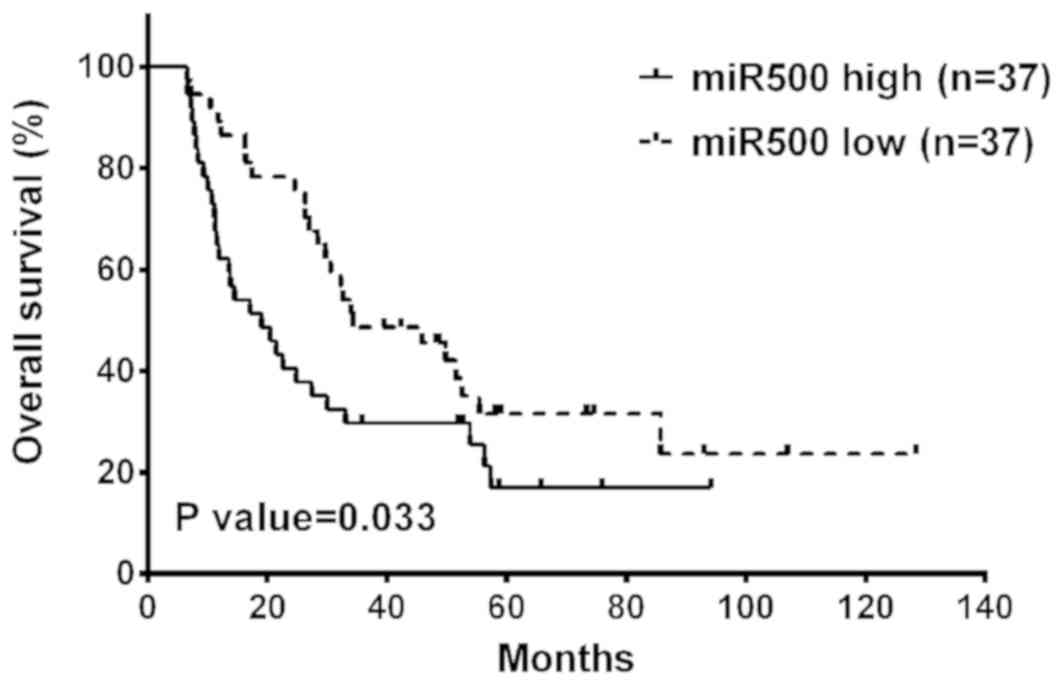|
1
|
Cazzola M, Della Porta MG, Travaglino E
and Malcovati L: Classification and prognostic evaluation of
myelodysplastic syndromes. Semin Oncol. 38:627–634. 2011.
View Article : Google Scholar : PubMed/NCBI
|
|
2
|
Wang YX, Zhang TJ, Yang DQ, Yao DM, Yang
L, Zhou JD, Deng ZQ, Ma JC, Guo H, Wen XM, et al: Reduced miR-215
expression predicts poor prognosis in patients with acute myeloid
leukemia. Jpn J Clin Oncol. 46:350–356. 2016. View Article : Google Scholar : PubMed/NCBI
|
|
3
|
Döhner H, Weisdorf DJ and Bloomfield CD:
Acute myeloid leukemia. N Engl J Med. 373:1136–1152. 2015.
View Article : Google Scholar : PubMed/NCBI
|
|
4
|
Marcucci G, Haferlach T and Dohner H:
Molecular genetics of adult acute myeloid leukemia: Prognostic and
therapeutic implications. J Clin Oncol. 29:475–486. 2011.
View Article : Google Scholar : PubMed/NCBI
|
|
5
|
Agirre X, Martínez-Climent JÁ, Odero MD
and Prósper F: Epigenetic regulation of miRNA genes in acute
leukemia. Leukemia. 26:395–403. 2012. View Article : Google Scholar : PubMed/NCBI
|
|
6
|
Zhang R and Su B: Small but influential:
The role of microRNAs on gene regulatory network and 3′UTR
evolution. J Genet Genomics. 36:1–6. 2009. View Article : Google Scholar : PubMed/NCBI
|
|
7
|
Palma CA, Tonna EJ, Ma DF and Lutherborrow
MA: MicroRNA control of myelopoiesis and the differentiation block
in acute myeloid leukaemia. J Cell Mol Med. 16:978–987. 2012.
View Article : Google Scholar : PubMed/NCBI
|
|
8
|
Calin GA, Dumitru CD, Shimizu M, Bichi R,
Zupo S, Noch E, Aldler H, Rattan S, Keating M, Rai K, et al:
Frequent deletions and down-regulation of micro- RNA genes miR15
and miR16 at 13q14 in chronic lymphocytic leukemia. Proc Natl Acad
Sci USA. 99:15524–15529. 2002. View Article : Google Scholar : PubMed/NCBI
|
|
9
|
Yamamoto Y, Kosaka N, Tanaka M, Koizumi F,
Kanai Y, Mizutani T, Murakami Y, Kuroda M, Miyajima A, Kato T and
Ochiya T: MicroRNA-500 as a potential diagnostic marker for
hepatocellular carcinoma. Biomarkers. 14:529–538. 2009. View Article : Google Scholar : PubMed/NCBI
|
|
10
|
Cai B, Chen W, Pan Y, Chen H, Zhang Y,
Weng Z and Li Y: Inhibition of microRNA-500 has anti-cancer effect
through its conditional downstream target of TFPI in human prostate
cancer. Prostate. 77:1057–1065. 2017. View Article : Google Scholar : PubMed/NCBI
|
|
11
|
Zhang L, Ding Y, Yuan Z, Liu J, Sun J, Lei
F, Wu S, Li S and Zhang D: MicroRNA-500 sustains nuclear factor-κB
activation and induces gastric cancer cell proliferation and
resistance to apoptosis. Oncotarget. 6:2483–2495. 2015.PubMed/NCBI
|
|
12
|
Cancer Genome Atlas Research Network, ;
Ley TJ, Miller C, Ding L, Raphael BJ, Mungall AJ, Robertson A,
Hoadley K, Triche TJ Jr, Laird PW, et al: Genomic and epigenomic
landscapes of adult de novo acute myeloid leukemia. N Engl J Med.
368:2059–2074. 2013. View Article : Google Scholar : PubMed/NCBI
|
|
13
|
Mrózek K, Marcucci G, Nicolet D, Maharry
KS, Becker H, Whitman SP, Metzeler KH, Schwind S, Wu YZ,
Kohlschmidt J, et al: Prognostic significance of the European
LeukemiaNet standardized system for reporting cytogenetic and
molecular alterations in adults with acute myeloid leukemia. J Clin
Oncol. 30:4515–4523. 2012. View Article : Google Scholar : PubMed/NCBI
|
|
14
|
Xue E, Tresoldi C, Sala E, Crippa A, Mazzi
B, Greco R, Messina C, Carrabba MG, Lupo Stanghellini MT, Marktel
S, et al: Longitudinal qPCR monitoring of nucleophosmin 1 mutations
after allogeneic hematopoietic stem cell transplantation to predict
AML relapse. Bone Marrow Transplant. 51:466–469. 2016. View Article : Google Scholar : PubMed/NCBI
|
|
15
|
Deol A, Sengsayadeth S, Ahn KW, Wang HL,
Aljurf M, Antin JH, Battiwalla M, Bornhauser M, Cahn JY, Camitta B,
et al: Does FLT3 mutation impact survival after hematopoietic stem
cell transplantation for acute myeloid leukemia? A Center for
International Blood and Marrow Transplant Research (CIBMTR)
analysis. Cancer. 122:3005–3014. 2016. View Article : Google Scholar : PubMed/NCBI
|
|
16
|
Tang S, Shen H, Mao X, Dai H, Zhu X, Xue
S, Ding Z, Lu J, Wu D and Tang X: FLT3-ITD with DNMT3A R882 double
mutation is a poor prognostic factor in Chinese patients with acute
myeloid leukemia after chemotherapy or allogeneic hematopoietic
stem cell transplantation. Int J Hematol. 106:552–561. 2017.
View Article : Google Scholar : PubMed/NCBI
|
|
17
|
Chan NP, Wong WS, Ng MH, Tsang KS, Lau TT,
Leung Y, Chik KW, Shing MM and Li CK: Childhood acute myeloid
leukemia with CBFbeta-MYH11 rearrangement: Study of incidence,
morphology, cytogenetics, and clinical outcomes of Chinese in Hong
Kong. Am J Hematol. 76:300–303. 2004. View Article : Google Scholar : PubMed/NCBI
|
|
18
|
Van Vlierberghe P, Patel J, Abdel-Wahab O,
Lobry C, Hedvat CV, Balbin M, Nicolas C, Payer AR, Fernandez HF,
Tallman MS, et al: PHF6 mutations in adult acute myeloid leukemia.
Leukemia. 25:130–134. 2011. View Article : Google Scholar : PubMed/NCBI
|










